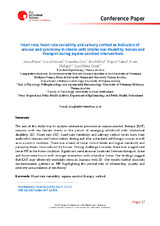Heart rate, heart rate variability and salivary cortisol as indicators of arousal and synchrony in clients with intellectual disability, horses and therapist during equine-assisted interventions
Autor
Naber, Anna
Kreuzer, Lena
Zink, Roswitha
Millesi, Eva
Palme, Rupert
Hediger, Karin
Glenk, Lisa Maria
Editor
Universidad de Córdoba, Departamento de Medicina y Cirugía AnimalFecha
2019Materia
Heart rate variabilityEquine-assisted therapy
Cortisol
METS:
Mostrar el registro METSPREMIS:
Mostrar el registro PREMISMetadatos
Mostrar el registro completo del ítemResumen
The aim of the study was to analyse interaction processes in equine-assisted therapy (EAT) sessions with ten female clients in the period of emerging adulthood with intelectual disability (ID). Heart rate (HR), heart rate variability and salivary cortisol levels have been analysed in humans and horses before, during and after a standardised therapy session as well as in a control condition. There was a trend of lower cortisol levels and higher variability and parasympathetic tone induced by horses. During challenge however, there was a significant lower HR in the horse condition. Significant correlations in heart rate between therapist, client and horse were found with stronger interaction with a familiar horse. Our findings suggest that EAT may effectively modulate stress in humans with ID. Our results further elucidate synchronisation patterns in HR highlighting the pivotal role of relationship quality and intensity as modulators of synchrony.

